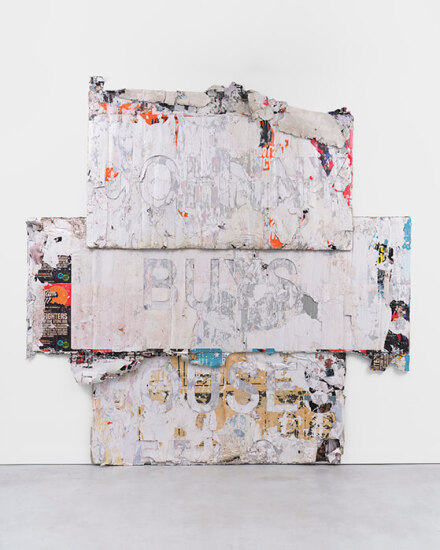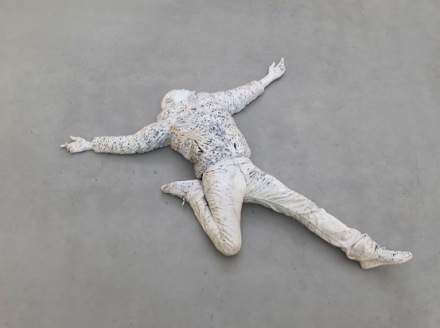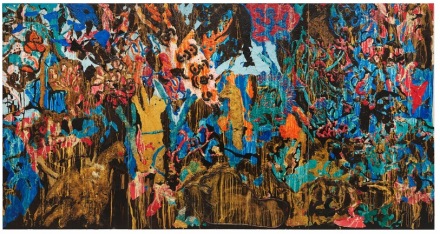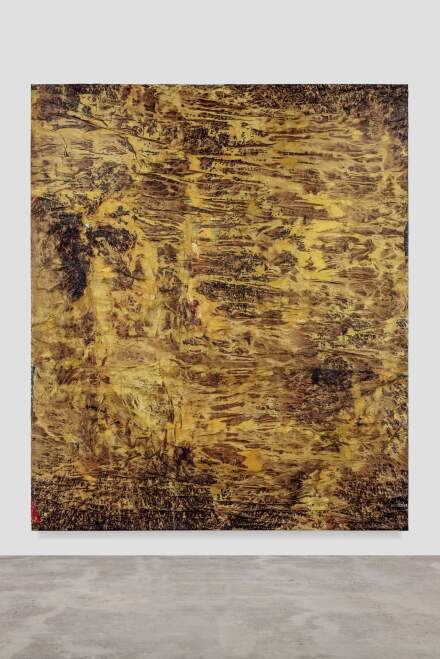
Mark Bradford, Manifest Destiny (2023), via Hauser & Wirth
On this month in New York, Hauser & Wirth presents the expansive new show from artist Mark Bradford. You Don’t Have to Tell Me Twice, a major exhibition that fills the entirety of the gallery’s 22nd Street building, marks the artist’s first show in New York since 2015, and sees him embarking upon a deeply personal exploration of the multifaceted nature of displacement and the predatory forces that feed on populations driven into motion by crisis.

Mark Bradford, Death Drop (2023), via Hauser & Wirth
Bradford’s work is relentless in both energy and scope, politically and emotionally dynamic in equal measure, and here turns to a new approach that both focuses on figuration, or rather, figures, in their relation to the landscapes and social matrices he has so often documented and explored. The first floor of the exhibition includes a group of recent paintings informed by the history of European tapestry and their socio-political significance, as symbols of the greatest opulence of European aristocracy, and, by extension, their relationship to power. Presented here, his works draw on rich layers and dense networks of allusion that factor in the Jim Crow South, the Mexican desert, and the American homesteader movement through a range of materials and allusions. Bradford snakes in a series of allusions to a symbolic antagonist nicknamed ‘Johnny the Jaguar’ by the artist, the roving beast comes to stand in for several kinds of historical predation explored through the exhibition.

Mark Bradford, Jungle Jungle (2021), via Hauser & Wirth
The juxtaposition of paintings from the two series of tapestries generates a strong connection between history and the present day, suggesting that the medieval period is a resonant metaphor for modern conflicts and social tensions that have been happening for centuries and remain intractable today. In formal terms, Bradford’s tapestry-like works shift the perspective in his celebrated oeuvre from the aerial bird’s-eye view of the cityscape familiar in his work since the early 2000s, to an interpersonal perspective that puts the audience on an eye-to-eye level with his allegorical world of survival, violence, and desire.

Mark Bradford, Where Lee Goodwin Was Jailed and Lynched (2023), via Hauser & Wirth
The exhibition also presents a group of monumental canvases––including the show’s namesake painting ‘You Don’t Have to Tell Me Twice’ (2023)––that continues Bradford’s ongoing exploration of the Great Migration of African Americans out of the South, perhaps the largest movement of people in the nation’s history. Based on a chart showing travel distances between railroad centers in the United States from the 1920s, these paintings feature gridded numbers and city names created with oxidized paper and caulk, forming a veritable parallel landscape of the continental United States. In these works, the vibrant palette of Bradford’s tapestry paintings give way to more muted tones of stained canvas and paper oxidized to soft grays, tans, and whites in a sober evocation of the urgency in uprooting oneself in the face of catastrophe. These are countered by a sculptural depiction of the artist’s body, Death Drop a larger-than-life sculpture of the artist’s body positioned in the iconic ‘death drop’ pose popularized in gay ballroom culture––gestures again to the intersection of performance and persecution. Taking his own body and placing it in concert with these divergent historical notes, Bradford orchestrates a powerful meditation on the body and systemic violence.
The show closes July 28th.
– D. Creahan
Read more:
Mark Bradford at Hauser & Wirth [Exhibition Site]



